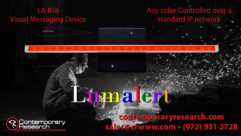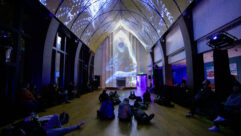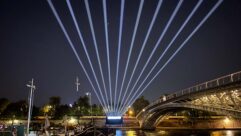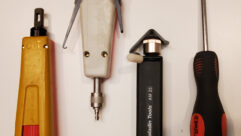SEE THE LIGHT
May 1, 1999 12:00 PM,
Irwin Math
Since the invention of television, virtually all closed-circuit videotransmission has been through coaxial cable. This method works well, butthere are limitations. It is important for the installer to be aware ofthese limitations and understand how fiber optics can be a viable andlow-cost alternative to common coax, especially over long distances.
The most common problem encountered with long-distance video transmissionis cable attenuation. Coaxial cable, by its physical nature, is a long,distributed capacitance. As a result, the effective capacitance reactanceincreases as a function of length; consequently, all coaxial cables exhibita frequency-dependent attenuation characteristic. Figure 1 shows thischaracteristic for RG-59/U, one of the most commonly used types of coax forstandard CCTV installations. As shown in the graph, the higher frequenciesare rolled off to a greater degree than the lower ones (at a given length),resulting in the loss of fine detail in the TV picture. When the signal iscolor, the 3.58 MHz subcarrier is degraded, and if the length of the coaxis sufficient, the color portion of the picture can disappear. Other typesof coax have lower losses, but the frequency-dependent attenuation alwaysremains.
In an attempt to correct for this attenuation, the signal is oftenequalized by pre-distorting the transmitted or received signal in a manneropposite to the cable attenuation, the degree of equalization beingdependent on the length of the cable. This method works, but it requiresadditional equipment in the form of EQs or repeater EQs for long runs. Thisincreases overall system cost and complexity. Furthermore, these units mustsometimes be fine tuned at both ends of a run, a difficult and awkward jobwhen distances exceeding 1,000 feet (305 m) are involved.
Fiber optic cable, on the other hand, does not have this problem. Figure 2is a graph of attenuation for common 62.5 mm (.0025 inches) run-of-the-millmultimode fiber over the same frequency range. Also shown on the graph isthe result for lengths of 3,000 feet (914.4 m) and 10,000 feet (3,048 m).Note that the bandwidth, in all cases, is essentially flat; only theabsolute value of attenuation changes. Because there is no frequencydistortion, a simple amp contained within the fiber optic receiver easilyreproduces the original signal.
Another common problem encountered with coax systems is the difference inground potential at each end of a camera/monitor link. Because the shieldof the coax is part of the signal path, any potential voltage difference atthe ground connection of this shield can cause some 60 Hz (50 Hz in Europe)to be mixed with the video information. Similarly, running the coax inclose proximity to AC power lines can also induce 60 Hz into the coax. Whenthis happens, it shows up as black rolling hum bars in the resultingpictures on the monitor. This can make viewing annoying, even impossible,if the amount of hum is great. It is interesting to note that even a fewmillivolts of 60 Hz impressed on the 1 Vpp video signal will be clearlyseen.
To reduce or eliminate this problem, commercial equipment is available thatuses differential inputs employing balanced transmission lines or, in somecases, transformer coupling. Even special clamper-amps that attempt tonegate the 60 Hz effect by using 15.75 kHz horizontal sync pulses asreference signals to reconstruct hum-free 60 Hz vertical sync informationexist. Using these accessories, however, increases costs and systemcomplexity.
A fiber optic cable, it should be noted, contains no metallic conductors.Consequently, unequal grounds or ground loops do not exist. Furthermore,optical fiber operates at frequencies that fall in the area of visiblelight, which is so far removed from 60 Hz (or 600 MHz for that matter) thatany close proximity to AC lines, electrical interference sources, unusuallyhigh RF fields or any other interference generator has no effect on thesignal being transmitted. Such other factors as current or voltage surges,hostile environments, short circuits and lightning-induced damage alsodisappear once an optical fiber link is chosen.
The Beamer V from Math Associates, for example, is an inexpensive,commercially available fiber optic transmission system specificallydesigned for video transmission applications with both black-and-white andcolor equipment. The transmitter and receiver are housed in separate,self-contained lightweight modules that are easily mounted directly tocameras or monitors with two screws or double-sided tape. Signal input andoutput connectors are BNC, and connections to the camera and monitor aremade with short 75 V RG-59/U coaxial cable jumpers. Power for the systemshown is 12 VDC and can usually be borrowed from the TV equipment itself orfrom an AC to DC call-type plug-in adapter. Batteries can be used inportable applications. Fiber optic cable is connected with industrystandard ST type connectors, and an entire link can be wired in minutes.The only necessary tool is a screwdriver to connect the 12 V to a removabletwo-position terminal block.
Figure 3 shows a simplified block diagram of the fiber optic transmitter.The 1 Vpp video signal from the CCTV camera is applied to a modulator thatcorrects for the nonlinearities of a high-speed LED, which is employed forthe transmitter’s light source. This LED is used to couple near IR energyinto an optical fiber whose active area or core is only 62.5 mm (.0025inches) in diameter. In this system, the light intensity of the LED isvaried in step with the video signal producing a so-called AM light signal.At the receiver, the light is detected by a sensitive low-noise photodiodeand applied to several amp stages. These raise the signal back up to the 1Vpp level and provide enough drive for a 75 V load, the monitor. Becausethe typical attenuation of the fiber optic cable is only 4 dB or so perkilometer at the optical wavelength produced by the LED, transmissiondistances of more than a mile are readily achieved.
Figure 4 is a drawing of a cross section of a typical fiber optic cable.The fiber itself is made of an ultra-pure glass core clad with an outerlayer of lower refractive index glass that serves to refract or bend thelight back toward the core. Some fibers are made of only one type of glasstreated so that light continuously bends toward the center of the fiber. Ineither case, a protective polymer layer is then extruded over the glasscladding layer and the resulting buffered fiber placed in a loose tube.This tube is then wound with a high-tensile strength yarn and the entireassembly further enclosed in a polyethylene or PVC outer jacket in much thesame way that coaxial cable is enclosed. Complete fiber optic cable oftenlooks just like miniature coax and is often made in a distinctive color(usually orange) for easy identification.
Cables such as this are ideally suited for use in underground conduits,cable trays, on telephone poles, in dropped ceilings or even stapled to abaseboard with a telephone installer’s staple gun. Pulling strengths of 200pounds (90 kg) to 400 pounds (180 kg) are common, and no more care isneeded in their installation than is required with miniature coax. The onlyrestriction involves the avoidance of pulling the cable around too sharp acorner; that practice might break the internal glass fiber. A minimum bendradius of 1 inch (25 mm) is normally acceptable. Because the fiber opticcable is non-conducting and does not support current flow, most of thenormal electrical code restrictions do not usually apply.
Figure 5 is a block diagram of the fiber optic receiver. The light from thefiber is applied to a high-speed silicon photodiode connected to ahigh-speed trans-impedance amp. This stage converts the modulated lightfrom the fiber into an exact replica of the original signal, sync and all.A post-amp stage then restores up to 20 dB of fiber cable attenuation andan output stage supplies fully reconstructed composite video into a 75 Vmonitor load. When operated at the normal 6 MHz to 10 MHz video channelbandwidth of the industry, color or black and white picture quality over6,000 feet (1,829 m) of fiber is indistinguishable from picture qualityover 3 feet (914.4 mm) of coax. As a point of reference, such a systemconsisting of a transmitter, receiver and two wall-type plug-in adapterscosts $399 list.
When comparing the cost of a fiber optic video transmission system withwhat is necessary in many cases to achieve an ultra-high quality CCTVpicture, one quickly finds that at distances beyond 1,000 feet (305 m), thefiber optic system is clearly competitive with the copper wire system,especially when equalizing or hum-reducing techniques must be employed. Anadded benefit is that the fiber optic cable can be installed wherever theinstaller wants without extraneous signal pickup. There is also theadditional insurance that the installation of an electrically generatingnoise source at some point in the future near the cable run will notdegrade the performance of the system, a strong case for the use of fiberoptics in video transmission systems.










